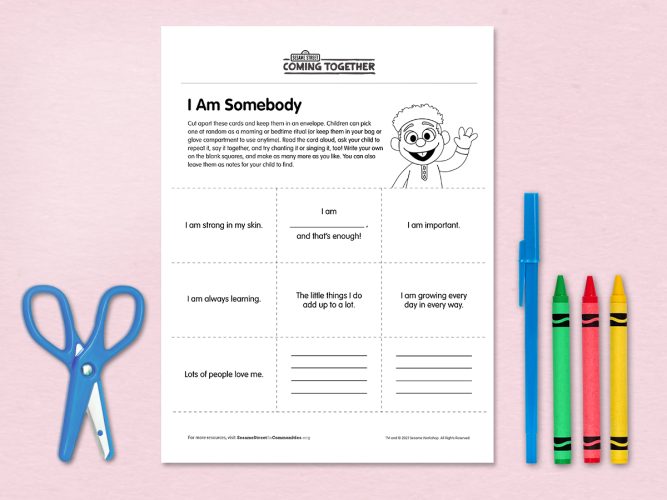
Week 5: Learning with Love
Confident children can embrace diversity and act as upstanders when someone is in need.
Welcome to Week 5, Day 1 of Room to Grow!
This week is all about teaching children confidence-building strategies when faced with a conflict related to race.
Day 1: Classroom Communities
Day 1: Classroom Communities
If a student is teased or “othered” based on the color of their skin, a particular physical feature, or the way they talk, they can internalize that and experience self-doubt and low self-esteem. You can validate their feelings while also reminding them that there are ways to help themselves feel better: they can talk to a grown-up, recite affirmations, or sing a song that comforts them and reminds them that they’re beautiful and important. This week also explores speaking up for oneself and knowing that it’s sometimes best to walk away.
Watch Proud of Your Eyes and Spanish is My Superpower .
The examples shared here are also a good reminder that racism exists beyond the Black and White binary, and children of different races have varied experiences.
Day 2: Provider to Parent
Day 2: Provider to Parent
Today is all about helping parents dive deeper into honest discussions with their children about racism while at home. For instance, conversations at the dinner table or reading a diverse collection of books can both lead to further exploring the many ways racism can present itself as well as the impacts of trauma caused by racism. Children who have experienced a racist incident may respond in different ways, and this can be influenced by their upbringing or the historical trauma (multigenerational trauma experienced by a specific cultural, racial or ethnic group) of their community.
Parents can talk to children about how to respond after they experience racism, whether they are the victim of unkind treatment or an upstander ready to advocate for their friend. They can also continue the practice of honest conversations around skin color, language, and facial features while celebrating the differences that make their family unique. Families may have different starting points for this conversation, but no matter where they begin, this article can help you remind them that even little moments and everyday routines can make a big impact.
Day 3: Fun with Families
Day 3: Fun with Families
Today is all about helping parents playfully engage with their children while also offering affirmations. Helping children find the words to describe what they love about themselves is a great way to build confidence, identity, and self-worth. Parents and children can stand at the mirror together and describe their favorite physical features, thoughts about what they’re good at, and how they want to treat themselves and others. Repeating positive affirmations is a helpful way to stay connected to our heads (what we’re thinking) and our hearts (what we’re feeling).
This activity is beneficial for all different types of military families, and may be a particularly helpful tool for those with children who have experienced racism. It can help you remind parents that even little moments and everyday routines can make a big impact.
Day 4: Professional Practice
Day 4: Professional Practice
Today is all about examining and assessing your knowledge and understanding of the various ways racist incidents may occur, and how to respond. Recognizing what this may look like in interactions between small children, and learning terminology you may not have previously been familiar with such as colorism (prejudice or discrimination within racial or ethnic groups that favors people with lighter skin color), are stepping stones to becoming more culturally aware and anti-racist (a person who opposes racism and promotes racial tolerance).
This video will help remind you that even little moments, asking questions, and everyday routines can make a big impact.
Day 5: Questions and Reflections
Day 5: Questions and Reflections
Self-reflection is an important part of the growth process. Sometimes this requires sitting in discomfort and learning more about yourself before moving on with immediacy. Looking inward can help you access more information about what hinders and motivates you, which is paramount to building a healthy and equitable community with others.
Take a moment to reflect on how your answers to the questions listed keep communities smarter, stronger, and kinder!
- How has the information shared in this week’s lesson shaped or changed previously held ideas?
- How have you been able to see a perspective different from the context you grew up in? What are some ways you can guide children in doing the same?
- What are the ways that caring adults can hold space for a child who is hurting after hearing an unkind comment about who they are? What are the ways we can proactively build community before this happens?
“Don’t be out in the sun that long or else you’ll get too dark.
As a child I would hear this on occasion from certain relatives who thought having lighter skin was better than having more melanated brown skin. I don’t blame them or even think they knew the harm their words caused, but I now know that this idea is deeply rooted in colorism. For a multitude of reasons that are rooted in discrimination and the construction of a racial hierarchy, many communities of color wrestle with this idea that lighter skin is favorable or preferred. This is important to be aware of because it could be an additional layer keeping a student of color from feeling confident in themselves.
No group of people comes in one shade or complexion, and we should all be celebrated as equally beautiful and wonderful! I love my brown skin and I do not take the advice of old and shy away from the sun.“
—Patricia A. Taylor, Anti-Racism Educator
Congratulations!
You’ve finished the Week 5!


